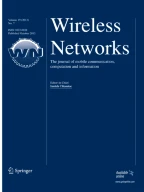Abstract
Cellular frequency reuse is known to be an efficient method to allow many wireless telephone subscribers to share the same frequency band. However, for wireless data and multi-media communications optimum cell layouts differ essentially from typical solutions for telephone systems. We argue that wireless radio systems for bursty message traffic preferably use the entire bandwidth in each cell. Packet queuing delays are derived for a network with multipath fading channels, shadowing, path loss and discontinuously transmitting base stations. Interference between cells can be reduced by appropriately scheduling transmissions or by ‘spatial collision resolution’.
Similar content being viewed by others
References
L. Kleinrock,Queuing systems, Vol. 1: Theory; Vol 2: Computer applications (Wiley, New York, 1975, 1976).
D. Bertsekas and R. Gallager,Data Networks (Prentice-Hall, London, 1987).
A.S. Tanenbaum,Computer Networks (Prentice-Hall, London, 1989).
J. Walrand,Communication Networks: A First Course, Aksen Associates, Series in Electrical and Computer Engineering, Homewood, IL, 1991.
J.P.M.G. Linnartz,Narrowband Landmobile Radio Networks (Artech House, Norwood, MA, 1993).
W. Gosling, Protection ratio and economy of spectrum use in land mobile radio, IEE Proc. 127 (1980) 174–178.
R.C. French,The effect of fading and shadowing on co-channel reuse in mobile radio, IEEE Trans. Veh. Tech. VT-28 (1979) 171–181.
D.C. Cox, Cochannel interference considerations in frequency reuse small-coverage-area radio systems, IEEE Trans. Comm. COM-30 (1982) 135–142.
K. Daikoku and H. Ohdate, Optimal channel reuse in cellular land mobile radio systems, IEEE Trans. Veh. Tech. VT-32 (1983) 217–224.
R. Prasad, A. Kegel and J. C. Arnbak, Improved assessment of interference limits in cellular radio performance. IEEE Trans. Veh. Tech. 40 (1991) 412–419.
R. Muammar and S.C. Gupta, Cochannel interference in high-capacity mobile radio systems, IEEE Trans. Commun. 30 (1982) 1973–1978.
Y.-D. Yao and A.U.H. Sheikh, Outage probability analysis for microcell mobile radio systems with cochannel interferers in Rician/Rayleigh fading environment, Electr. Lett. 26 (1990) 864–866.
R. Prasad and A. Kegel, Effects of Rician faded and log-normal shadowed signals on spectrum efficiency in micro-cellular radio, IEEE Trans. Veh. Tech. VT-42 (1993) 274–285.
J.P.M.G. Linnartz, Exact analysis of the outage probability in multiple-user mobile radio, IEEE Trans. Commun. COM-40 (1992) 20–23.
K.W. Sowerby and A.G. Wilkinson, Estimating reception reliability in Cellular mobile radio systems, Proc. 42nd IEEE. Veh. Tech. Conf. Denver (1992) 151–154.
M.-J. Ho, G.L. Stüber, Co-channel interference of microcellular systems on shadowed Nakagami fading channels, 43rd IEEE VTC 1993, Seracucus, NJ (1993) 568–571.
S. Chennakeshu, A. Hassan and J. Anderson, Capacity analysis of a mixed mode slow frequency hopped cellular system, Proc. IEEE 43rd Veh. Tech. Conf. (1993) 540–543.
J.P.M.G. Linnartz, A.J. 't Jong and R. Prasad, Effect of coding in digital microcellular personal communication system with cochannel interference. IEEE J. Select. Areas Commun. JSAC-11 (1993) 901–910.
M. Nakagami, Them-distribution—A general formula for the distribution of rapid fading,Statistical Methods in Wave Propagation, ed. W.C. Hoffman (Oxford/Pergamon, 1960) 3–36.
J. Griffiths and J.P. McGeehan, Interrelationship between some statistical distributions used in radio wave propagation. IEE Proc. 129 (1982) 411–417.
H. Harley, Short distance attenuation measurements at 900 MHz and 1.8 GHz using low antenna heights for micro-cells, IEEE J. Select. Areas Commun. JSAC-7 (1989) 5–10.
D. Verhulst, M. Mouly and J. Szpirglas, Slow frequency hopping multiple access for digital cellular radio telephone, IEEE J. Select Areas Commun. JSAC-2 (1984) 563–574.
J.P.M.G. Linnartz, Effect of delay spread and noise on outage probability in cellular network, Int. J. Electr. Commun. (Archiv für Elektronik und Übertragungstechnik AEÜ) 48 (1994) 14–18.
S.C. Schwartz and Y.S. Yeh, On the distribution function and moments of power sums with log-normal components, Bell Syst. Tech. J. 61 (1982) 1441–1462.
D. Goodman et al., Packet reservation multiple access for local wireless communications, IEEE Trans. Commun. 37 (1989) 885–890.
S.H. Strogatz and I. Stewart, Coupled oscillators and biological synchronization, Sci. Amer. (Dec. 1993) 68–75.
R. Litjens, Conflict-free scheduling of broadcasts in a linear packet radio network, M.Sc. Thesis, Department of Econometrics, Tilburg University, The Netherlands (1994).
C. van den Broek et al., A simulation study of space time reservation multiple access, submitted for conference presentation (1995).
Author information
Authors and Affiliations
Rights and permissions
About this article
Cite this article
Linnartz, JP.M.G. On the performance of packet-switched cellular networks for wireless data communications. Wireless Netw 1, 129–138 (1995). https://doi.org/10.1007/BF01202536
Received:
Issue Date:
DOI: https://doi.org/10.1007/BF01202536
